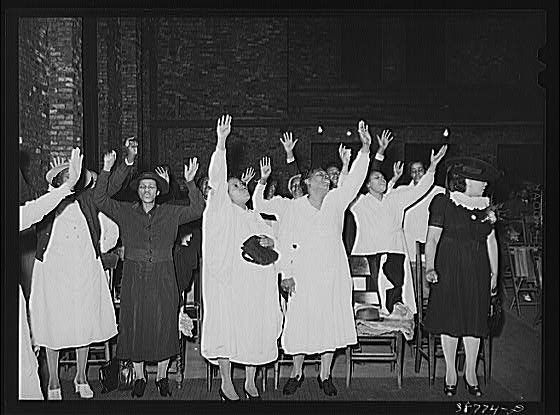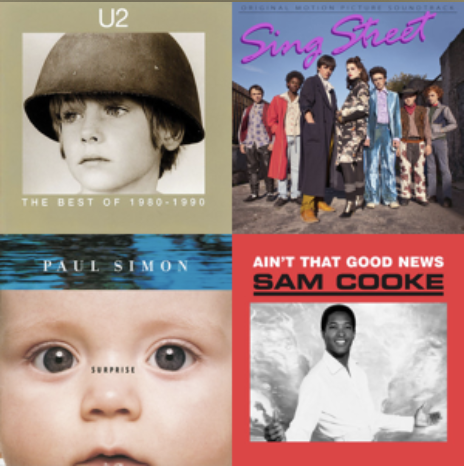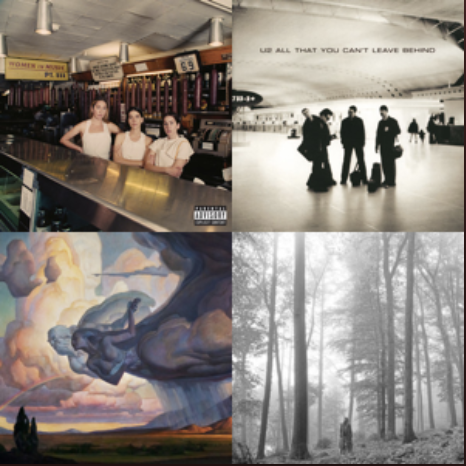Editor’s Note: This paper was originally presented as part of Calvin College’s Festival of Faith and Music. This biennial conference brings together musicians, critics, journalists, artists, and listeners to discuss and celebrate popular music—hoping to bridge the gap between the church and popular art. The Curator is delighted to share thoughtful music criticism from the 2015 Festival. Over the coming months, The Curator will publish one paper a week in order to continue and extend the conversation from the Festival. On a range of artists and songs, each paper engages and interprets popular music from a faith perspective.
It is a fascinating, quintessentially American story.
A group of white and black Americans got together and crashed the racial boundaries of the time. They held ecstatic celebrations with the wildest of music. Their language was unintelligible to “outsiders.” Indeed, outsiders truly believed that these people had lost their minds.
If you think this describes the story of rock music in America, you would, of course, be right. But if you think I have just described the story of the modern Pentecostal movement in America, you would also be right.
Any short list of the pioneers of rock ‘n’ roll that best exemplify the crazy, and frankly, unhinged approach–both the wildest and the most joyous–to making this music starts with Elvis Presley, Little Richard, and Jerry Lee Lewis. Aside from being three of rock’s most crucial and most electrifying artists, each was raised and musically formed in the Pentecostal churches of the South.
Pentecostals are sometimes known by the pejorative nickname “holy rollers,” due to parishioners being “slain in the Spirit” and literally writhing and rolling in the church aisles. The actual tenets of Pentecostalism are taken from Acts 2. On Pentecost the Holy Spirit came “like the rush of a mighty wind,” bringing charismatic experiences such as speaking in tongues, or glossolia, faith healing, and visions (Act 2:17).
Glossolia, as theologian Harvey Cox describes it, is the stream of consciousness verbalizing of “clearly discernable but incomprehensible syllables.” It is a spontaneous occurrence, sometimes frightening to the uninitiated. As he further explains, it sometimes includes “music, a polyphony of tones and vocables but with no recognizable words.” Speaking in tongues is said to be a spiritual, universal language, but one which even the speaker does not know the exact meaning of what is being said.
The Biblical passages on glossolia were generally ignored over the years, but this changed with the birth of the modern Pentecostal movement in the 20th century. In 1898, former Methodist preacher and Kansan Charles Fox Parham sparked the movement. An African-American Holiness preacher, William Joseph Seymour, heard Parham’s sermons and took the cause to Los Angeles where he started his own congregation on Azusa Street in 1905. Seymour’s first congregants were poor blacks and white domestic servants. In fact, Pentecostalism would long be known as a movement of the poor, and today it enjoys a large, worldwide following.
To the Pentecostal, charismatic experiences facilitated something beyond a rote, theoretical understanding of the Holy Spirit and represented how salvation was more than a heavenly destination. Instead, each individual could experience a deep and personal connection with God and feel this Holy Spirit in the here and now. This spirituality provided a link between the spiritual and physical.
And physically their worship did seem to be unhinged in both word and sound. There was the “polyphony of tones” that composed acts of glossolia and their music including the use of secular instrumentation such as drums and guitars and, equally shocking, strong blues and jazz influences. This would open the door so that the reverse would be true, as the secular rock and rollers would clearly be influenced by the Pentecostal experience. Yet both groups shared more than instrumentation and music, both met with similar shock and disdain.
From the beginning, fundamentalist Protestants looked down on the Pentecostals, seeing them as an embarrassment, while Pentecostals spurred the dogma and the stifling doctrines of “text driven” fundamentalists, instead focusing on a personal experience of God. Pentecostals spontaneously spoke out, sang, spoke in tongues and were otherwise “slain in Spirit.” As writer Arthur Cox put it, they were “[n]o longer praying for a revival; they were the revival.” Outsiders, however, including the Los Angeles press, called them a “Weird Babel of Tongues” and labeled them “Fanatics.”
As to rock, the 1950s establishment could not make heads nor tails of Richards’ screaming, Presley’s gyrating, nor Lewis’ banging out a wild beat on his piano. To this, The New York Times quoted a psychiatrist that branded rock and roll as “cannibalistic and tribalistic,” while pop star Frank Sinatra described “imbecilic reiterations” delivered by “cretinous goons” (this was still a few years before he embraced rock and roll and covered Beatles’ and others rock songs). America’s youth were the revival, as well.
The Pentecostal performer most responsible for this link, for bringing the “reeling and rocking” of the Pentecostal church to rock ‘n’ roll is Sister Rosetta Tharpe. Tharpe was tremendously popular in the 1940s as a gospel/R&B crossover star, though she oddly remained essentially unknown until her biography was published in 2008 and a segment on PBS’s American Masters, last year. PBS even started a petition to get Tharpe into the Rock and Roll Hall of Fame.
As a child, Tharpe traveled performing with her evangelizing mother for COGIC (Church of God in Christ). Tharpe had strong blues and jazz influences, an independent streak, and pushed the sacred-secular line her entire career. Tharpe had hits with bouncing, up-tempo takes on gospel standards, and performed with the likes of Cab Calloway and Benny Goodman’s popular jazz orchestras. Early on, her deep and moving ability to cross and blur the boundaries of gospel, blues and jazz was unlike anything anyone had heard. Tharpe confounded the press who didn’t know how to classify her; variously describing her as a “swingcopated manipulator of loud blue tones” and a “Hymn swinging evangelist.”
Viewing videos of Tharpe’s performances today is jarring. In one black-and-white clip, a 47-year-old black woman is seen wearing a conservative, ankle-length dress playing an electric guitar in a church setting. Yet Tharpe is not simply singing the gospel, she is rocking the gospel. The footage is actually from a television show in 1962, but the black-and-white stock and the conservative dress make it seem much older.
When the rock revolution came in the mid-50s, however, the youth were looking for one of their own to lead the way—not a 47-year-old with strong ties to the church. As Tharpe had already lost much of her church-going fan base, sadly her name and music faded from the story. Yet Tharpe embodies the link between the sacred and the secular, and she was indeed a profound influence on the first wave of rock icons.
She was, in fact, both Richard and Johnny Cash’s all-time favorite singer. Carl Perkins learned the guitar on a Tharpe’s “Strange Things (Are Happening Every Day).” Perkins said of the song, “It was rockabilly, that was it—it was.” Lewis sung a Tharpe song as part of his first audition for Sam Phillips, the legendary owner of Sun Studio in Memphis. After seeing Tharpe perform live in 1957, Lewis commented, “I said, ‘Say, man, there’s a woman that can sing some rock ‘n’ roll.’ I mean, she’s singing religious music, but she is singing rock ‘n’ roll. She’s… shakin’, man…She jumps it. She’s hitting that guitar, playing that guitar and she is singing. I said, ‘Whoooo.’ Sister Rosetta Tharpe.” Through Tharpe, the Pentecostal influence is an undeniable part of rock’s genesis.
Like rock music, Pentecostalism tapped into something—a Holy Spirit—a human spirit? Whatever it was, it was deep. Pentecostalism was an antidote to rigid and stifling fundamentalist practices, while rock was bucking an oppressive life as a “square,” resisting the “rat race” in an age of anxiety. Cox, described the charismatic experience as “so total it shatters the cognitive packaging,” while rock musician Bobbie Gillespie described the “global psychic jailbreak” that was the onset of rock and roll. Both phenomena existed beyond any known social or cultural reference points. Whatever this Holy/human spirit is, if it is something, it was exactly what many needed. The Pentecostal-rock connection is a wonder of sacred-secular relations, and nothing could be more American than that.
CitationsAltschuler, G. (2003). All shook up: How rock ‘n’ roll changed America. Oxford: Oxford University Press.
Cox, Harvey (2001). Fire From Heaven: The Rise of Pentecostal Spirituality and the Reshaping of Religion in the 21st Century. DaCapo. Faupel.
Gillespie, Bobbie (2010). “Chuck Berry: hail. hail, rock ‘n’ roll.” The Guardian. Retrieved March 2, 2013.
Guralnick, P. (1994). Last train to Memphis: The rise of Elvis Presley. Boston: Little, Brown and Company.
Wald, Gayle F. (2008) Shout, Sister, Shout!: The Untold Story of Rock-and-Roll Trailblazer Sister Rosetta Tharpe, Beacon Press, Boston.
WEBWIRE, (2008) “Pennsylvania Governor Rendell Proclaims Sister Rosetta Tharpe Day on January 11, 2008 to Honor the Gospel Music Legend.” 1/2/2008. Retrieved from http://www.webwire.com/ViewPressRel.asp?aId=56002.#.VAfTbvldV8E.




